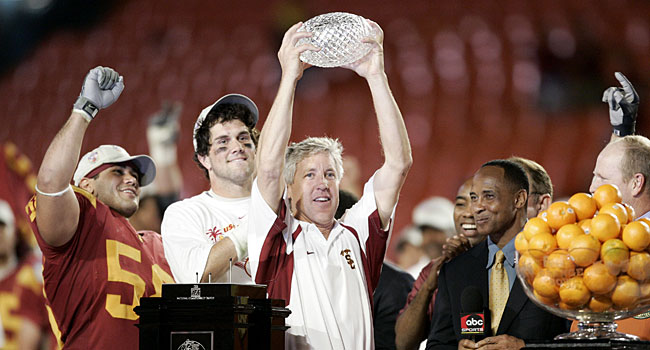
Throughout June and July and to commemorate the final year of the BCS era, Jerry Palm will be taking a year-by-year look at the machinations and controversies of the postseason system unleashed upon college football in 1998. Previous installments of the series can be found HERE.
Format: The championship game was the Orange Bowl. The regular Orange Bowl wasn’t played.
Number of bowls: 28. New bowls: none.
Number of Division I-A teams: 117. New schools: None.
Conference realignment: The first major shakeup happened. The ACC raided the Big East for the first time, taking Miami and Virginia Tech. The Big East officially added UConn on the football side, though. Also, Troy joined the Sun Belt.
Formula changes: After a 2003 season that saw the No. 1 team in the polls get left out of the BCS title game, the math geeks at BCS HQ finally came to the realization that the only way to reduce the possibility of the top two poll teams not playing for the title was to give the polls more influence in the formula. A new formula was developed. Gone was the explicit strength-of-schedule element, as well as the ridiculous quality win factor. The number of losses was also dropped as part of the formula. That left only the AP Poll, the Coaches' Poll and the computer average, each of which was given 1/3 weight in the formula.
Also, the New York Times decided to drop its computer ranking because of ethical concerns over being so intimately involved in a story that it covers. That’s Journalism Ethics 101, but the AP had been part of the BCS from the beginning, so obviously not everyone shared the same concern at that point. And let’s not forget the ethical nightmare that allows the coaches, who have millions of dollars at stake, to participate in this system.
Instead of using the poll rankings, the BCS decided to use a percentage of the best possible poll score for each team. The formula took the point total for each team and divided it by the point total a team would have if it were the unanimous No. 1 team. That would result in a number between zero and one, with one being best.
For the computer average, each of the six remaining computer ranking systems were treated like they were a Top 25 vote in a poll. The top-rated team in each computer got 25 points, the No. 2 team got 24, and so on, down to one point for the No. 25 team. Then, the high and low were dropped, the others were added together and divided by 100, to produce a score between zero and one.
The three scores were then averaged to give a final score between zero and one, high score being better.
All of this effort was for naught, though, because nobody can come up with a formula to put three teams into one game, and that is what was needed again in 2004.
USC and Oklahoma started the season as the top two teams in the polls. Both teams finished undefeated and never budged from those spots, so they met for the BCS title. That did not sit well with SEC champion Auburn, which also finished 12-0 but was third in both polls and all six computers. SEC fans think an undefeated conference champion has a birthright to a national title game. Auburn was clearly hurt by preseason poll positioning, but also a very poor nonconference schedule that held them down in the computers and watered down their argument for a place in the top two. The Tigers did beat Virginia Tech in the Sugar Bowl.
That was not the only controversy that year. The teams battling for fourth place were also battling for an automatic at-large spot in a BCS game, thanks to the ill-advised Kansas State rule ensuring that a team from a major conference that didn't win its league but still finished in the top four in the rankings would receive an at-large spot. This would be the second time it would be invoked, and it would again stick a bowl with a team that it would rather not have.
Cal was just barely ahead of Texas entering the final week of the regular season. If the Bears finished fourth, they would make their first Rose Bowl appearance since 1958 (replacing league champ USC). That would make the Rose Bowl very happy. Whichever team finished fifth would be out of the BCS entirely because the other at-large team was undefeated No. 6 Utah, which became the first non-BCS conference team to automatically qualify for an at-large spot.
The Bears’ lead over Texas was small enough that if just a handful of voters switched the two teams on their ballots, Texas would move ahead and get the BCS berth. Now, AP voters were starting to sweat. Their ethical dilemma was now obvious. There was a possibility that one of them could decide the fate of Cal and Texas and which league would get the big financial windfall that comes with a second BCS participant. It didn’t help them that AP votes are public each week. It was revealed that some Texas-based AP voters did not have the Longhorns ahead of Cal on their ballots. Those voters had their email boxes flooded with arguments of varying elegance on behalf of Texas, and a few threats.
Cal’s last game was a makeup game at Southern Miss that had been postponed from mid-September due to Hurricane Ivan. The Bears won 26-16, but that wasn’t enough to keep some voters from switching to Texas, and the Longhorns finished fourth in the BCS and played in the Rose Bowl instead of Cal. There is no doubt in my mind that if that Cal-USM game was played as scheduled in September, with the same result, the Bears would have gone to the Rose Bowl instead of Texas.
If the soon-to-be-launched four-team playoff were in place: Considering the battle for fourth place in the BCS described above, you would think the selection committee would go through the same struggles. There is no doubt about that, but they would also consider undefeated Utah as well, and I believe would give the Utes the nod. That would give us a playoff with four undefeated teams.
Pittsburgh was the champion of the watered-down Big East in 2004, automatically participated in the BCS, and got crushed by Utah in the Fiesta Bowl. In this system, the Panthers miss out. Utah gets the automatic at-large spot for the nonmajor conferences. Boise State also finished undefeated in 2004 and would probably get a spot in one of the big bowls. There isn’t room for five undefeated teams in this playoff system, though. Louisville from Conference USA finished 10-1 and in the top 10 as well, so it was a really good year for the nonmajors.
Rose Bowl: No. 1 USC vs. No. 4 Utah
Sugar Bowl: No. 2 Oklahoma vs. No. 3 Auburn
Cotton Bowl: Texas vs. Michigan
Peach Bowl*: Louisville vs. Georgia
Orange Bowl: LSU vs. Virginia Tech
Fiesta Bowl: Cal vs. Boise State
*- The Peach Bowl became the Chick-fil-A Bowl in 2006.




















